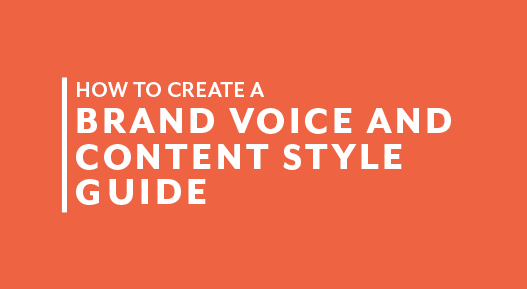If you want to elevate your brand’s reputation and position your company as an industry thought leader, your messaging and communications must be consistent across the board.
Your voice, tone and style are an extension of your business.
Whether you’re the CEO writing a memo to employees, a lawyer drafting a contract or a salesperson creating a new pitch deck, a great content marketing style guide sets the bar for the look, quality and feel of every piece of content produced at your organization.
Today, we’re sharing our best practices for creating a killer brand voice and content style guide that’ll take your communications game to the next level.
Download our FREE brand voice and style guide template.
Why You Need a Brand Voice and Content Style Guide
There’s a big misconception that only writers need or use a content style guide. But that’s not true.
Every person, vendor or partner working with your company should adhere to the brand voice and content style guide.
Every employee at an organization represents the brand in one way or another. And all forms of branded content — such as emails, social media posts, memos, announcements, product descriptions, sales presentations and ads — should follow the content style guide.
These guidelines help your business accomplish the following:
- Focus on your target audience. A brand voice and content style guide defines your ideal audience and outlines the best way to communicate with them.
- Standardize your content. Having the same set of standards makes it easier to produce consistent, high-quality content and promote best practices with everything you create.
- Scale your content strategy. At some point, you won’t be able to train every person who walks in the door. A content style guide is a great training tool to get everyone up to speed without sacrificing quality.
Get more FREE guides to master content marketing and 10x your results.
How to Create Your Brand Voice and Content Style Guide
You know the merits of documenting your brand voice — but how do you put it into practice?
Start by solidifying your brand positioning and brand voice characteristics. Then, you’ll get down to the nitty-gritty details of content style and formatting.
Here’s the complete guide on how to create a brand voice:
Brand Voice Guidelines Template
First, you need to define your brand. There are multiple components of influence: brand positioning, buyer personas, voice and tone.
Step 1: Think About Your Brand Positioning
What is your brand’s purpose? Where does your brand fit within your industry?
To decipher your brand positioning, consider these factors:
- Your why, how and what: As Simon Sinek says, “People don't buy what you do; they buy why you do it.” Too few companies lead with their “why,” — but your purpose is more compelling to prospective customers than flashy products or features alone. Document your company’s mission, how you carry it out and what you offer to create clear, mission-first messaging that the entire company can get behind.
- Brand promise: What value do you provide to clients or customers? What problems do you solve for them? This should be measurable and meaningful.
- Market landscape: Where do you fit in the marketplace? Is your brand new, or are you globally recognized?
- Key differentiators: What makes your brand stand out from the competition? Why should customers choose you over your competitors? Don’t be afraid to brag.
- Approach towards competitors: Sometimes, you may need to mention your competitors’ services or products. How would you approach this? Will you speak about your competitors objectively but with honesty, or shy away from mentioning them altogether?
Step 2: Identify Your Brand Voice
The brand voice is your brand’s personality. It’s how your audience would describe you and how you want others to perceive your brand in any situation.
Imagine your ideal customer. What would they say about you? Are you friendly and relaxed? Polished and professional? Modern or innovative? Energetic?
Don’t forget to include details and context so that anyone who comes across your style guide interprets these descriptors the same way. For instance, “friendly” can have different definitions depending on who you’re talking to.
You’ll also want to mention any negative attributes (i.e., “we are not aggressive”) and address any lines your brand would never cross. Provide examples where necessary.
For a team exercise on brand voice, click the link at the end of the blog to download our free guide, which includes a brand voice chart to help your team hone your brand’s personality.
Step 3: Identify Your Brand Tone
Tone is what your brand sounds like.
Think of it this way: you only have one voice, but you use a different tone when you’re angry, sad or excited. Tone is dynamic and changes based on the situation at hand.
When you're defining your tone, think about your customer. What tone would they expect you to use? Are you chatty? Opinionated? Rational and decisive? Witty? Inspirational?
It’s crucial to know what’s important to your target audience, so your message and tone can adapt accordingly in different scenarios. Plan messages in advance to avoid hasty miscommunications that don’t properly reflect your brand or values.
Step 4: Develop Buyer Personas
A buyer persona is a detailed description of your ideal customer. Based on market research and real customer data, well-defined personas help ensure every message (webpage, blog post, ad, social media post, etc.) speaks directly to your target audience.
Shape your buyer personas based on customer demographics, behavior patterns, pain points, motivations and goals.
If you’re an agency, you’ll want to interview your clients for in-depth information on their buyer personas. For a more detailed guide, check out our blog post on how to develop a buyer persona!
The more context you have about your buyers, the easier it will be to communicate with them. You’ll understand exactly what they’re looking for and how you can craft a compelling message that answers their question or solves their problem.
Content Style Guidelines
After documenting your brand voice, tone and buyer personas, it’s time to move on to the meat of your content style guide.
Style is what your content looks like. Your content style guide should cover everything from punctuation and grammar to formatting, sentence length and images.
This section is about the details. Settle the debate on the Oxford comma. Decide whether you will use bullets or dashes when you publish lists in a blog post.
Documenting your style is a critical component of your content style guide. It's also the section that will evolve and change the most as you grow.
Here's a step-by-step guide to creating the style section:
Step 1: Choose A Style Guide
After defining your voice and tone, you need to set some ground rules.
You’ll never be able to list every grammar rule out yourself. Professional English grammar and usage guides help create consistency and give teams a resource to reference when they have questions.
Here are two popular style guides for you to choose from:
- The Associated Press (AP) Stylebook is used by writers who work in newspapers or magazines. If you’re not sure which grammar style guide to go with, this one's always a solid choice.
- The Chicago Manual of Style is one of the oldest, most comprehensive guides. It’s a beast of a resource used by book authors. (You may not need this level of detail.)
Note: If you subscribe to these references, add the credentials to your style guide so everyone can access them.
Step 2: List Out Common Style Rules
Based on the style guide you choose, list out everyday or common industry rules as a shorthand for your team. Highlight and correct common mistakes you find repeatedly to save your team time.
Examples of standard style rules include numbers, dates, times, titles, cities and states, name references, common technical terms, acronyms and serial or Oxford commas.
Step 3: Document Exceptions
As you create content, you’ll discover exceptions, nuances and rules that are specific to (or don’t fit) your brand.
For instance, some stakeholders might prefer a particular writing style or word usage, while others don’t mind using sarcasm or humor in their communications.
Document these distinctions, so everyone on your team understands the best approaches.
Make note of any technical writing exceptions, such as capitalization, comma usage or hyphen usage.
For example, the AP Stylebook hyphenates “e-commerce.” In the marketing world, industry jargon has nixed the hyphen. As a marketing agency, we’ve chosen to go with the industry version, “ecommerce.”
Step 4: Document Common Internal Mistakes
Mistakes happen — some more than others. Thoroughly document mistakes that you see happening consistently. In the long run, this will reduce the time and effort spent on writing, proofreading and publishing.
Step 5: List Formatting Conventions
With writers, developers, managers and coordinators touching content every day, there are bound to be inconsistencies.
Avoid them by documenting formatting conventions.
This includes everything from line spacing to the look of your blog posts. It’s the little details that help create consistency.
Here are some examples:
- Headings: What size headings do you use on your website and blog posts? What about subheadings? Bolded or un-bolded?
- Lists: Do you use bullet points? Dashes? And when?
- Spacing: Should you double-space between every paragraph? What about between text and images?
These may seem inconsequential, but rest assured they make your content more readable and your website more cohesive.
Step 6: Include Additional Guidelines on Other Forms of Content
As content trends evolve, so should your style guidelines. Be sure to add any rules that apply to other forms of content or media, such as emojis, GIFs or videos.
If you’re creating or sharing content for a variety of platforms, you might need to tweak your voice or tone depending on the audience. For example, a caption on an Instagram video won’t necessarily translate well to LinkedIn.
Be Sure to Follow Through
A content style guide is useless if you don’t use it daily. Send it out to the team, review it often and remind others during meetings. If they have questions regarding voice, tone or style, direct them to the document first.
Your brand voice and content style guide is a living, breathing document that should grow alongside your business. As you create marketing campaigns, onboard new team members or debate the Oxford comma, you’ll need to update and reference the content style guide often. Use it or lose it!
Producing high-quality, consistent content is a top focus for us at Human. If you need a hand developing your brand voice and content style guide or want to take the next step in advancing your content marketing and SEO strategy, shoot us a message, and we’ll be happy to help.




